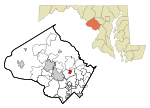Aspin Hill Memorial Park

Aspin Hill Memorial Park, also known as Aspin Hill Pet Cemetery, is a pet cemetery located in Aspen Hill, Maryland, at the intersection of Georgia Avenue and Aspen Hill Road, 7.5 miles (12.1 km) north of Washington, D.C. The cemetery contains more than 50,000 pet burials, and more than 50 human burials. Aspin Hill Memorial Park is a designated individual site on Montgomery County, Maryland's Master Plan for Preservation.Established in 1920, it is the fifth oldest pet cemetery in continuous operation in the United States. Hartsdale Pet Cemetery, established in 1896, is the oldest, followed by Pine Ridge Pet Cemetery (1907), Francisvale Home for Smaller Animals Pet Cemetery (1909), and Hillside Acre Animal Cemetery at Nevins Farm (1917).
Excerpt from the Wikipedia article Aspin Hill Memorial Park (License: CC BY-SA 3.0, Authors, Images).Aspin Hill Memorial Park
Wendy Lane,
Geographical coordinates (GPS) Address Nearby Places Show on map
Geographical coordinates (GPS)
| Latitude | Longitude |
|---|---|
| N 39.079444444444 ° | E -77.076666666667 ° |
Address
Wendy Lane 3813
20906
Maryland, United States
Open on Google Maps







